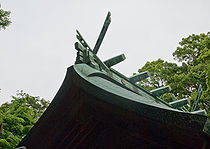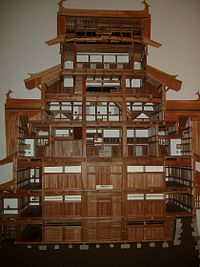- Chigi (architecture)
-
Chigi (千木, 鎮木, 知木, 知疑), Okichigi (置千木) or Higi (氷木) are forked roof finials found in Japanese and Shinto Architecture. Chigi predate Buddhist influence and are an architectural element endemic to Japan.[1] They are an important aesthetic aspect of Shinto shrines, where they are often paired with katsuogi, another type of roof ornamentation. Today, chigi and katsuogi are used exclusively on Shinto buildings and distinguish them from other religious structures, such as Buddhist temples in Japan.
Contents
Origin
Chigi is thought to have been employed on Japanese buildings starting from the 1st century AD[2]. Their existence during the Jōmon period (250–538) is well documented by numerous artifacts.[3] Measurements for chigi were mentioned in an early document, the Taishinpō Enryaku Gishikichō (太神宝延暦儀式帳), written in 804 AD.
The evolutionary origins of the chigi are not known. One theory is that they were simply interlocking bargeboard planks that were left uncut. Another is that they were part of a support system anchored on the ground to stabilize the roof [4]. Yet another theory proposes that they were used to "pinch" and hold thatch roofing together.[5] Evidence of this can be seen in minka, or common traditional homes, where two interlocking timbers are often found at the roof gables. However, the only certain fact is that chigi were originally a working part of the structure, but as building techniques improved, their function was lost and they were left as decorations.
Chigi were likely only to have decorated the homes and warehouses of powerful families, and more decorations signified higher rank. This traditional continued until relatively recent times. In the 17th to 19th centuries, the legal code dictated how many chigi were allowed on a building roofs in accordance with the owner's social rank. Today, chigi are found only on Shinto shrines.
Design
Chigi may be built directly into the roof as part of the structure, or simply attached and crossed over the gable as an ornament. The former method is believed to closer resemble its original design, and is still utilized in older building methods such as shinmei-zukuri, kasuga-zukuri, and taisha-zukuri.
Chigi that aren't built into the building are crossed, and sometimes cut with a slight curve. While chigi are predominantly placed only at the ends of the roof, this method allows them to sometimes be placed in the middle as well.
More ornate chigi, such as at Ise Shrine, are cut with one or two kaza-ana, or "wind-slots", and a third open cut at the tip, giving it a forked appearance. Gold metal coverings serve both protective and ornamental purposes. Usually, if the tops are cut vertically, the enshrined kami is a male, otherwise a female.[6]
The katsuogi, a short decorative log, is often found behind the chigi. Depending on the building, there may be only one katsuogi accompanying the chigi, or an entire row along the ridge of the roof.
Names
Names for chigi can vary from region. In Kyoto, Nara Prefecture, and Hiroshima, they are called uma (馬). In parts of Toyama, Osaka, Kōchi, Tokushima and Miyazaki prefectures, they are called umanori (馬乗); in some areas of Yamagata, Miyagi, Yamanishi, Hiroshima and Kōchi prefectures, they are called kurakake (鞍掛).
Images
-
The Honden of Kibitsu Shrine
See also
- Katsuogi
- Shinto architecture
- Shinto shrine
- The Glossary of Shinto for terms concerning Shinto and Shinto architecture.
Notes
- ^ Fletcher (1996), page 724
- ^ "chigi 千木." JAANUS. Retrieved on May 09, 2009.
- ^ Watanabe, Yasutada (1974). Shinto art: Ise and Izumo shrines. New York, Tokyo: Weatherhill/Heibonsha. p. 123.
- ^ "Japanese Shinto Shrine". http://aggv.bc.ca/Catalogues+Pages.aspx?catalogue=16&page=487. Retrieved May 9, 2009.[dead link]
- ^ Lucas (2002), page 5
- ^ Bocking, Brian (1997). A Popular Dictionary of Shinto. Routledge. ISBN 978-0700710515. http://www.amazon.com/dp/0700710515.
References
- Fletcher, Banister, Sir. (1996). A History of Architecture. Architectural Press. ISBN 0750622679.
- Lucas, B. (2002, May 7). History and Symbolism in Shinto Shrine Architecture. Harvey Mudd College Web. Retrieved June 1, 2009
Elements of Japanese architecture Styles Buddhist · Buke · Daibutsuyō · Gassho · Giyōfū · Hachiman · Hirairi · Hiyoshi (also called Hie) · Irimoya · Ishi-no-ma · Kasuga · Kibitsu · Nagare · Ōbaku Zen · Setchūyō · Shinden · Shinmei · Shinto · Shoin · Sukiya · Sumiyoshi · Taisha · Wayō · ZenshūyōBuilding types Roof styles Structural Burdock piling · Chigi · Disordered piling · Engawa · Fusuma · Hisashi · Irimoya-zukuri · Irori · Jinmaku · Katōmado · Katsuogi · Kuruwa · Mokoshi · Moya · Nakazonae · Namako wall · Nightingale floor · Onigawara · Ranma · Shōji (see also washi) · Sōrin · Tamagaki · Tatami · Tokonoma · Tokyō · Tsumairi · ShibiGates and approaches Rooms Furnishings Outdoor objects Measurements Groups See also Shinto shrine Shinto architecture Buildings - chōzuya or temizuya
- haiden
- heiden
- hokora
- honden / shinden / shōden
- kagura-den
- massha
- sessha
Architectonic elements Styles - hirairi-zukuri
- tsumairi-zukuri
- gongen-zukuri
- hachiman-zukuri
- hiyoshi-zukuri
- irimoya-zukuri
- ishi-no-ma-zukuri
- kasuga-zukuri
- kibitsu-zukuri
- misedana-zukuri
- nagare-zukuri
- ōtori-zukuri
- owari-zukuri
- ryōnagare-zukuri
- shinmei-zukuri
- sumiyoshi-zukuri
- taisha-zukuri
Others Implements Main kami Staff Head shrines1 - Fushimi Inari Taisha
- Usa Hachiman-gū
- Ise Grand Shrine
- Dazaifu Tenman-gū
- Munakata Taisha
- Suwa Taisha
- Hiyoshi Taisha
- Kumano Nachi Taisha
- Tsushima Shrine
- Yasaka Shrine
Miscellaneous 1 (in order of the size of the shrine network they head)
Categories:- Japanese architectural features
- Classical Japan
Wikimedia Foundation. 2010.








